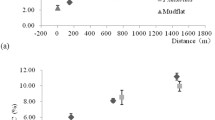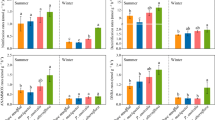Abstract
Invasive alien plants increase both plant N and soil inorganic N pools in many terrestrial ecosystems. This is believed to be the result of altered plant–soil–microbe feedbacks that accelerate N cycling. However, it may also be due to the greater ability of invasive species to uptake lateral N subsidies that can modify ecosystem N dynamics. We conducted manipulative field experiments to determine the impact of smooth cordgrass (Spartina alterniflora) invasion on the N cycling of salt marsh ecosystems in the Yangtze Estuary, China. The results showed that the aboveground plant N and soil inorganic N pools in S. alterniflora marshes, 14.39 and 3.16 g N m−2, were significantly higher than those in native common reed (Phragmites australis) marshes, 11.61 and 2.29 g N m−2. These increases after invasion were explained by a significantly higher uptake of dissolved inorganic N (DIN) from tidal subsidies in S. alterniflora marshes (6.59 g N m−2) than from those in P. australis marshes (1.61 g N m−2), and not by soil organic N mineralization, which was not significantly different between S. alterniflora (6.45 g N m−2) and P. australis marshes (6.84 g N m−2) during the growing season. Our study indicated that the ecosystem engineering effects of S. alterniflora, which increases the interception of external N input, can be an alternative mechanism that increases plant N and soil inorganic N pools—especially in ecosystems with ample anthropogenic N subsidies, such as the coastal wetlands of China.








Similar content being viewed by others
References
Ashton IW, Hyatt LA, Howe KM, Gurevitch J, Lerdau MT (2005) Invasive species accelerate decomposition and litter nitrogen loss in a mixed deciduous forest. Ecol Appl 15:1263–1272
Bart D, Hartman JM (2000) Environmental determinants of Phragmites australis expansion in a New Jersey salt marsh: an experimental approach. Oikos 89:59–69
Casselman ME, Patrick WH, Delaune RD (1981) Nitrogen fixation in a Gulf-coast salt-marsh. Soil Sci Soc Am J 45:51–56
Chai C, Yu ZM, Shen ZL, Song XX, Cao XH, Yao Y (2009) Nutrient characteristics in the Yangtze River Estuary and the adjacent East China Sea before and after impoundment of the Three Gorges Dam. Sci Total Environ 407:4687–4695
Chambers RM (1997) Porewater chemistry associated with Phragmites and Spartina in a Connecticut tidal marsh. Wetlands 17:360–367
Chen JY, Zhu HF, Dong YF, Sun JM (1985) Development of the Changjiang Estuary and its submerged delta. Cont Shelf Res 4:47–56
Chung CH (2006) Forty years of ecological engineering with Spartina plantations in China. Ecol Eng 27:49–57
Crooks JA (2002) Characterizing ecosystem-level consequences of biological invasions: the role of ecosystem engineers. Oikos 97:153–166
Cuddington K, Hastings A (2004) Invasive engineers. Ecol Model 178:335–347
Currin CA, Pearl HW (1998) Epiphytic nitrogen fixation associated with standing dead shoots of smooth cordgrass, Spartina alterniflora. Estuaries 21:108–117
Davidson-Arnott RGD, van Proosdij D, Ollerhead J, Schostak L (2002) Hydrodynamics and sedimentation in salt marshes: examples from a macrotidal marsh, Bay of Fundy. Geomorphology 48:209–231
Ehrenfeld JG (2003) Effects of exotic plant invasions on soil nutrient cycling processes. Ecosystems 6:503–523
Frasco BA, Good RE (1982) Decomposition dynamics of Spartina alterniflora and Spartina patens in a New Jersey salt marsh. Am J Bot 69:402–406
Hanson RB (1977) Comparison of nitrogen-fixation activity in tall and short Spartina alterniflora salt-marsh soils. Appl Environ Microbiol 33:596–602
Ivancic I, Degobbis D (1984) An optimal manual procedure for ammonia analysis in natural waters by the indophenol blue method. Water Res 18:1143–1147
Keeney DR, Nelson DW (1982) Nitrogen—inorganic forms. In: Page AL, Miller RH, Keeney DR (eds) Methods of soil analysis, part 2. American Society of Agronomy, Madison
Knops JMH, Bradley KL, Wedin DA (2002) Mechanisms of plant species impacts on ecosystem nitrogen cycling. Ecol Lett 5:454–466
Laland KN, Odling-Smee FJ, Feldman MW (1999) Evolutionary consequences of niche construction and their implications for ecology. Proc Nat Acad Sci 96:10242–10247
Laungani R, Knops JMH (2009) Species-driven changes in nitrogen cycling can provide a mechanism for plant invasions. Proc Nat Acad Sci 106:12400–12405
Leonard LA, Wren PA, Beavers RL (2002) Flow dynamics and sedimentation in Spartina alterniflora and Phragmites australis marshes of the Chesapeake Bay. Wetlands 22:415–424
Levine JM, Vila M, D’Antonio CM, Dukes JS, Grigulis K, Lavorel S (2003) Mechanisms underlying the impacts of exotic plant invasions. Proc Roy Soc Lond B Biol Sci 270:775–781
Li B, Liao CH, Zhang XD, Chen HL, Wang Q, Chen ZY, Gan XJ, Wu JH, Zhao B, Ma ZJ, Cheng XL, Jiang LF, Chen JK (2009) Spartina alterniflora invasions in the Yangtze River estuary, China: an overview of current status and ecosystem effects. Ecol Eng 35:511–520
Liao CZ, Luo YQ, Jiang LF, Zhou XH, Wu XW, Fang CM, Chen JK, Li B (2007) Invasion of Spartina alterniflora enhanced ecosystem carbon and nitrogen stocks in the Yangtze Estuary, China. Ecosystems 10:1351–1361
Liao CZ, Luo YQ, Fang CM, Chen JK, Li B (2008a) Litter pool sizes, decomposition, and nitrogen dynamics in Spartina alterniflora-invaded and native coastal marshlands of the Yangtze Estuary. Oecologia 156:589–600
Liao CZ, Peng RH, Luo YQ, Zhou XH, Wu XW, Fang CM, Chen JK, Li B (2008b) Altered ecosystem carbon and nitrogen cycles by plant invasion: a meta-analysis. New Phytol 177:706–714
Liu M, Xu SY, Hou LJ (2007) Environmental biogeochemical processes of nutrients at sediment–water interface in tidal flats of Yangtze Estuary (in Chinese). Science Press, Beijing
Lovel GL (1997) Biodiversity—global change through invasion. Nature 388:627–628
Mack RN, Simberloff D, Lonsdale WM, Evans H, Clout M, Bazzaz FA (2000) Biotic invasions: causes, epidemiology, global consequences and control. Ecol Appl 10:689–710
Mack MC, D’Antonio CM, Ley R (2001) Alteration of ecosystem nitrogen dynamics by exotic plants: a case study of C4 grasses in Hawaii. Ecol Appl 11:1323–1335
Meyerson LA, Saltonstall K, Windham L, Kiviat E, Findlay S (2000) A comparison of Phragmites australis in freshwater and brackish marsh environments in North America. Wetlands Ecol Manage 8:89–103
Mitsch WJ, Gosselink JG (1993) Wetlands. Van Nostrand Rheinhold, New York
Newell SY, Hopkinson CS, Scott LA (1992) Patterns of nitrogenase activity (acetylene-reduction) associated with standing, decaying shoots of Spartina alterniflora. Estuar Coast Shelf Sci 35:127–140
Norman RJ, Edberg JC, Stucki JW (1985) Determination of nitrate in soil extracts by dual-wavelength ultraviolet spectrophotometry. Soil Sci Soc Am J 49:1182–1185
Parker IM, Simberloff D, Lonsdale WM, Goodell K, Wonham M, Kareiva PM, Williamson MH, von Holle B, Moyle PB, Byers JE, Goldwasser L (1999) Impact: toward a framework for understanding the ecological effects of invaders. Biol Invasions 1:3–19
Raison RJ, Connell MJ, Khanna PK (1987) Methodology for studying fluxes of soil mineral–N in situ. Soil Biol Biochem 19:521–530
Rout ME, Callaway RM (2009) An invasive plant paradox. Science 324:734–735
Sala OE, Chapin FS, Armesto JJ, Berlow E, Bloomfield J, Dirzo R, Huber-Sanwald E, Huenneke LF, Jackson RB, Kinzig A, Leemans R, Lodge DM, Mooney HA, Oesterheld M, Poff NL, Sykes MT, Walker BH, Walker M, Wall DH (2000) Biodiversity—global biodiversity scenarios for the year 2100. Science 287:1770–1774
Sax DF, Stachowicz JJ, Brown JH, Bruno JF, Dawson MN, Gaines SD, Grosberg RK, Hasting SA, Holt RD, Mayfield MM, O’Connor MI, Rice WR (2007) Ecological and evolutionary insights from species invasions. Trends Ecol Evol 22:465–471
Seabloom EW, Williams JW, Slayback D, Stoms DM, Viers JH, Dobson AP (2006) Human impacts, plant invasion, and imperiled plant species in California. Ecol Appl 16:1338–1350
Simberloff D (2006) Invasional meltdown 6 years later: important phenomenon, unfortunate metaphor, or both? Ecol Lett 9:912–919
Sperry LJ, Belnap J, Evans RD (2006) Bromus tectorum invasion alters nitrogen dynamics in an undisturbed arid grassland ecosystem. Ecology 87:603–615
Stenger R, Priesack E, Beese F (1996) In situ studies of soil mineral N fluxes: some comments on the applicability of the sequential soil coring method in arable soils. Plant Soil 183:199–211
Stock WD, Wienand KT, Baker AC (1995) Impacts of invading N2-fixing Acacia species on patterns of nutrient cycling in two cape ecosystems—evidence from soil incubation studies and N15 natural-abundance values. Oecologia 101:375–382
Tyler AC, Mastronicola TA, McGlathery KJ (2003) Nitrogen fixation and nitrogen limitation of primary production along a natural marsh chronosequence. Oecologia 136:431–438
Vitousek PM, Howarth RW (1991) Nitrogen limitation on land and in the sea—how can it occur? Biogeochemistry 13:87–115
Vitousek PM, Walker LR (1989) Biological invasion by Myrica faya in Hawaii—plant demography, nitrogen-fixation, ecosystem effects. Ecol Monogr 59:247–265
Wang Q, Wang CH, Zhao B, Ma ZJ, Luo YQ, Chen JK, Li B (2006) Effects of growing conditions on the growth of and interactions between salt marsh plants: implications for invasibility of habitats. Biol Invasions 8:1547–1560
Weinstein MP, Kreeger DA (2002) Concepts and controversies in tidal marsh ecology. Kluwer, Dordrecht
Windham L, Ehrenfeld JG (2003) Net impact of a plant invasion on nitrogen-cycling processes within a brackish tidal marsh. Ecol Appl 13:883–896
Wright JP, Jones CG (2006) The concept of organisms as ecosystem engineers ten years on: progress, limitations, and challenges. Bioscience 56:203–209
Xu HF, Zhao YL (2005) Comprehensive surveys in Chongming Dongtan nature reserve for migratory birds, Shanghai (in Chinese). Chinese Forestry, Beijing
Yang SL (1999) Sedimentation on a growing intertidal island in the Yangtze River mouth. Estuar Coast Shelf Sci 49:401–410
Yang SL, Li H, Ysebaert T, Bouma TJ, Zhang WX, Wang Y, Li P, Li M, Ding P (2008) Spatial and temporal variations in sediment grain size in tidal wetlands, Yangtze Delta: on the role of physical and biotic controls. Estuar Coast Shelf Sci 77:657–671
Zedler JB, Kercher S (2004) Causes and consequences of invasive plants in wetlands: opportunities, opportunists, and outcomes. Crit Rev Plant Sci 23:431–452
Zhou HX, Liu JE, Zhou J, Qin P (2008) Effect of an alien species Spartina alterniflora Loisel on biogeochemical processes of intertidal ecosystem in the Jiangsu coastal region, China. Pedosphere 18:77–85
Acknowledgments
We are very grateful to Naishun Bu, Meng Lu, Chenghuan Wang, Long Tang and Jinqing Wang for their assistance, and Martin Wattenbach, Chengzhang Liao, Qing Wang, and Guanghui Lin for constructive comments on the earlier versions of this paper. This work was financially supported by National Basic Research Program of China (Grant No. 2009CB119201), National Science Foundation of China (Grant No. 30930019) and Science and Technology Commission of Shanghai (Grant Nos. 07JC14002, 07DZ12038 and 10JC1400700).
Author information
Authors and Affiliations
Corresponding author
Additional information
Communicated by Pascal Niklaus.
Rights and permissions
About this article
Cite this article
Peng, R.H., Fang, C.M., Li, B. et al. Spartina alterniflora invasion increases soil inorganic nitrogen pools through interactions with tidal subsidies in the Yangtze Estuary, China. Oecologia 165, 797–807 (2011). https://doi.org/10.1007/s00442-010-1887-7
Received:
Accepted:
Published:
Issue Date:
DOI: https://doi.org/10.1007/s00442-010-1887-7




